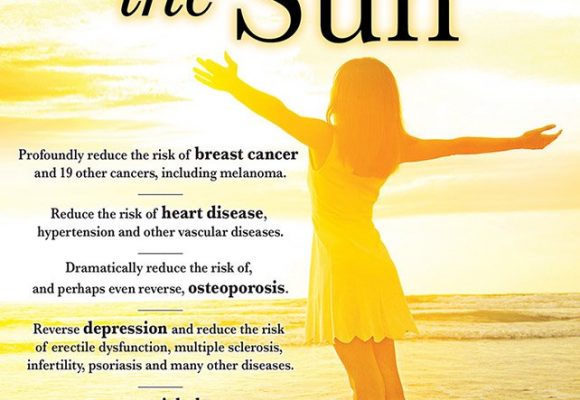Marc Sorenson, EdD
What is IBD?
First of all, IBD consists of two primary diseases, ulcerative colitis (UC)  and Crohn’s disease (CD). UC is a chronic inflammatory condition characterized by relapsing and remitting episodes of inflammation limited to the mucosal layer of the colon.[1] Crohn’s disease, however, can involve any part of the gastrointestinal tract from the mouth to the anus. Yet, it most commonly affects the small intestine or the colon, or both.[2]
and Crohn’s disease (CD). UC is a chronic inflammatory condition characterized by relapsing and remitting episodes of inflammation limited to the mucosal layer of the colon.[1] Crohn’s disease, however, can involve any part of the gastrointestinal tract from the mouth to the anus. Yet, it most commonly affects the small intestine or the colon, or both.[2]
The gift of sunlight
First of all, there is a beautiful gift that may prevent or lessen IBD. The gift, (sunlight) awaits us, but if we do not accept the gift, we are no better off than if we didn’t have it. So it is in Italy, where those who suffer from IBD are shown to have far less sun exposure than those who do not have the disease.[3] Therefore, this may indicate that part of the cause of IBD is lack of sunlight. And in Italy, low sun exposure probably indicates a reluctance to step outside because, Italy is a sunny country. Maybe, many of the Italians who succumb to IBD, have obviously not accepted the gift. Either that, or they are using too much sunscreen, since sunscreen blocks the sun.
Furthermore, IBD patients are at an increased risk for fractures. Hence, one may conclude that both maladies may be due to low sun exposure.
Embrace the sun to prevent IBD
Another investigation, conducted over 12 years and involving hundreds of thousands of IBD patients produced remarkable outcomes. Hospitalizations for both UC and CD were far higher among those with low sun exposure.[4] And, the same relationship was shown between sun exposure, bowel surgeries and deaths: more surgeries were needed for those patients who experienced the lowest sun exposure. Also, more deaths occurred among those with low exposure.
And what about non-IBD patients?
Another side note to this investigation was the large number of non-IBD patients analyzed for sun exposure levels. It is most noteworthy that the same relationship existed as with the IBD patients. Low sun exposure associated with prolonged hospitalizations and more deaths when compared with high exposure. Especially relevant is other research involving the association of Crohn’s disease to surgery. It found that surgery for the disease was significantly reduced among patients who received more sun exposure.[5]
The north-south gradient
In addition, research shows that in the US, there is a north-south gradient for IBD risk.[6], [7], [8], [9] The risk of developing the disease is significantly lower in southern latitudes (because sun exposure is greater).
An important nutritional note about IBD:
In addition to what we have heretofore described, it is especially relevant to understand that IBD causes malabsorption of nutrients in the gut. Consequently, it leads to diseases of malnutrition.[10] And, vitamin D is one of the “nutrients” that may not be absorbed efficiently. Therefore, sun exposure (or sunlamps) may be the only viable source of vitamin D for a person with IBD.
Most of all, remember that non-burning sun exposure is essential to human health. It seems like a good idea to obtain your share, and protect your gut from IBD.
[1] Peppercorn M, Cheifetz, A, Rutgeerts P, Grover S. Definition, epidemiology, and risk factors in inflammatory bowel disease. http://www.uptodate.com/contents/definition-epidemiology-and-risk-factors-in-inflammatory-bowel-disease.
[2] Web MD http://www.webmd.com/ibd-crohns-disease/crohns-disease/inflammatory-bowel-syndrome.
[3] Vernia P, Burrelli Scotti G, Dei Giudici A, Chiappini A, Cannizzaro S, Afferri MT, de Carolis A. Inadequate sunlight exposure in patients with inflammatory bowel disease. J Dig Dis. 2018 Jan;19(1):8-14
[4] Limketkai BN, Bayless TM, Brant SR, Hutfless SM. Lower regional and temporal ultraviolet exposure is associated with increased rates and severity of inflammatory bowel disease hospitalization. Aliment Pharmacol Ther. 2014 Sep;40(5):508-17.
[5] Govani SM, Higgins PD, Stidham RW, Montain SJ, Waljee AK. Increased ultraviolet light exposure is associated with reduced risk of inpatient surgery among patients with Crohn’s disease. J Crohns Colitis. 2015 ;9(1):77-81
[6] Schultz M, Butt AG. Is the north to south gradient in inflammatory bowel disease a global phenomenon? Expert Rev Gastroenterol Hepatol. 2012 Aug;6(4):445-7.
[7] Kappelman MD, Rifas-Shiman SL, Kleinman K, Ollendorf D, Bousvaros A, Grand RJ, Finkelstein JA. The prevalence and geographic distribution of Crohn’s disease and ulcerative colitis in the United States. Clin Gastroenterol Hepatol. 2007 Dec;5(12):1424-9.
[8] Sonnenberg A. Similar geographic variations of mortality and hospitalization associated with IBD and Clostridium difficile colitis. Inflamm Bowel Dis. 2010 Mar;16(3):487-93.
[9] Holmes EA, Xiang F, Lucas RM. Variation in incidence of pediatric Crohn’s disease in relation to latitude and ambient ultraviolet radiation: a systematic review and analysis. Inflamm Bowel Dis. 2015 ;21(4):809-17
[10] Margulies SL, Kurian D, Elliott MS, Han Z. Vitamin D deficiency in patients with intestinal malabsorption syndromes–think in and outside the gut. J Dig Dis. 2015 Nov;16(11):617-33.



[…] Find more information on http://sunlightinstitute.org/, particularly at this link: http://sunlightinstitute.org/low-levels-of-sunlight-exposure-predispose-to-inflammatory-bowel-diseas… […]